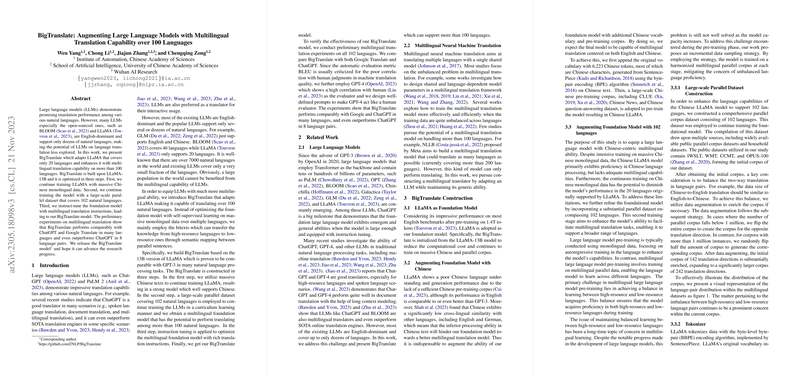An Expert Assessment of BigTranslate: Enhancing LLMs with Multilingual Translation Capabilities
In the paper "BigTranslate: Augmenting LLMs with Multilingual Translation Capability Over 100 Languages," the authors tackle a critical limitation in the field of LLMs, which have traditionally exhibited strong proficiency primarily in English and a limited set of other languages. By introducing BigTranslate, the authors aim to bridge the gap in multilingual translation capabilities by adapting the LLaMA model to support over 100 languages.
The paper begins by contextualizing the existing landscape of LLMs, highlighting their potential in translation tasks but also pointing out their limitations in terms of language support. The research then presents BigTranslate, a model built upon LLaMA-13B, which originally supports only 20 languages. The methodology involves a three-step optimization process to enhance LLMs with multilingual capabilities.
The optimization process includes:
- Continued Training with Chinese Monolingual Data: This step focuses on strengthening the model's capabilities in Chinese, a language that typically exhibits low cross-lingual similarity with others. By doing so, the model is better positioned to serve as a bridge for Chinese-centered multilingual translation.
- Training on a Large-Scale Parallel Dataset: The authors incorporate a parallel dataset covering 102 languages to augment the LLMs with multilingual functionality. This involves a novel incremental curriculum learning approach to improve balance across both high-resource and low-resource languages.
- Instruction Tuning: The final step involves refining the multilingual model with structured translation instructions, enhancing its ability to generate translations in diverse contexts.
Evaluation results show BigTranslate performing comparably to established systems like ChatGPT and Google Translate in many language pairs. Notably, in 8 language pairs, BigTranslate even surpasses ChatGPT. A significant element of their evaluation was employing GPT-4 to supplement BLEU scores, given recognized limitations in BLEU's correlation with human judgment.
Implications and Speculation on Future Developments
The authors' work enhances our understanding of how integrating comprehensive multilingual datasets and strategic instruction tuning can bridge performance gaps in LLMs across a broad spectrum of languages. Practically, this contributes to expanding LLM applications in global markets, enabling access for a larger baseline of the world's population for whom technology solutions in their native languages were previously limited.
From a theoretical perspective, the incremental data sampling strategy, akin to curriculum learning, introduces a structured methodology that can be extended to other LLM advancements beyond translation, inviting further research into balancing learning between resource-rich and resource-poor languages.
In future developments, there could be a pivot towards enhancing BigTranslate's ability in low-resource languages without relying heavily on data augmentation. Additionally, exploring the transfer of other LLM capabilities—such as semantic understanding and question-answering—into these newly supported languages could further improve the model's broad applicability.
Overall, the paper effectively contributes to advancing LLM capabilities, and future research could focus on refining translation quality and extending the model's capacities in other sophisticated NLP tasks, thereby continuing to democratize AI access and usability across linguistic demographics.
